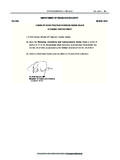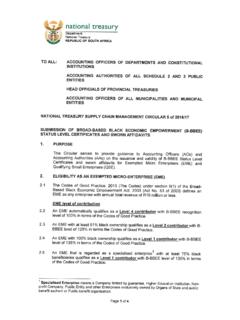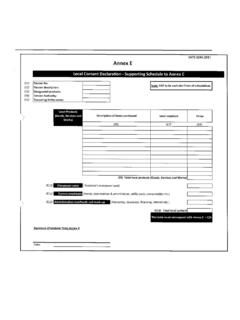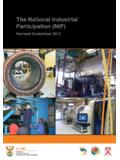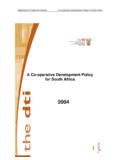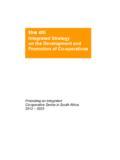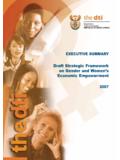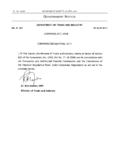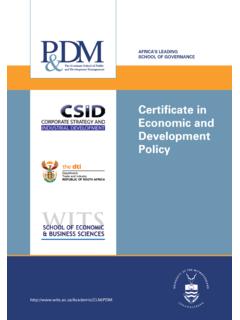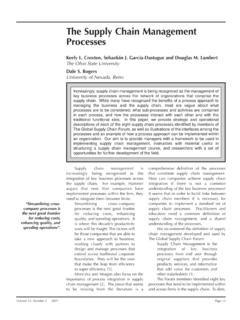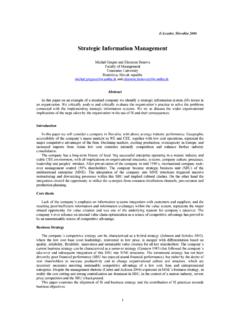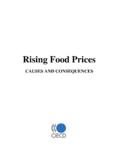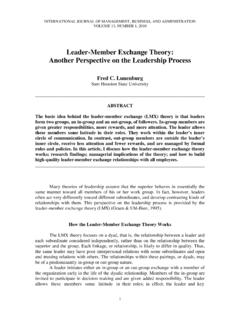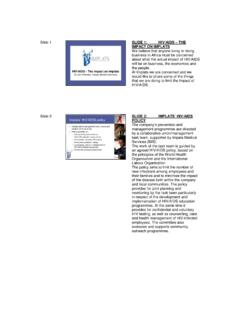Transcription of South African and global food-processing trends: Dl ...
1 South African and global g food - processing trends : D. Development l t implications Prof Justin Barnes Prof. Benchmarking and Manufacturing Analysts SA (Pty) Ltd, in association with Impact Economix Presentation outline Outline of research completed Critical research findings Recommendations to develop the South African food processing value chain: Policy Polic Regulatory Project-specific P j t ifi Outline of research completed Secondary research: government reports, academic papers (focus on SA and comparator t economies)i ). Primary research: stakeholder interviews, annual report interrogations, BMA food - processing database, database trade and production data analysis, demographic modelling Then, Then detailed analysis of primary and secondary research findings, and compilation of strategic considerations for the development of the South African food - processing sector, with identification of prioritised value chains Interrogation g of findings g with dti officials Critical findings global horizon scan World population to grow from billion (2010).
2 To billion in 2050. Asia to remain most p populated p region, g , but majority j y of growth stems from Africa, with an annual CAGR. of To 2050, all populations will also age food demand will therefore be linked to extended average life spans Populations in developing economies will continue to undergo the nutrition transition and increase their caloric consumption as per capita incomes rise implications for food production are significant: Cereals production will need to increase by 1 billion tons in the 40 years to 2050, to approx. 3 billion tons per annum (excluding biofuels cereals). Meat production will need to increase by 200 million tons Yet, any further expansion of agricultural land is considered a threat to global ecological biodiversity, while productivity gains due to scientific farming methods have declined food security issues to therefore become an increasing concern global overview: Trade profile and t trends d Increased global trade in food products has been driven by: Population growth Increasing income levels Declining trade barriers Increased investment in processed food production This has mobilised the transfer of developed economy trends to the rest of the world ( supermarkets).
3 Globalization of the food value chain has raised health and ethical issues, hence the rise of phyto-sanitary standards ( , HACCP), and the growth (off a small base) of organic/fair trade market demands in major developed economies global overview: Competitiveness profile of the food - processing food processing industry Key drivers of food processing competitiveness appear to be: Customer return rates Equipment and line changeovers Raw material inventory holding Absenteeism Due to the perishable nature of most products, customer returns imply major costs to processors, as do raw material inventories that expire or are damaged prior to undergoing processing . Similarly, the ability to achieve fast turnaround times on production processes via assembly line and/or equipment changeovers is again linked to the short lifespan of most food consumables global overview: Retailer research Buyer-driven value chain Buying-end of the food industry is intensely competitive Large retailers compete with conventional and specialty supermarkets natural foods stores, supermarkets, stores discount warehouses, warehouses smaller specialty stores, farmers' markets, and restaurants Competition is on the basis of price, product differentiation, and an ability to define niche market space.
4 These all play a role in de-commoditising product offerings Comparator economy analysis Analysed food policy strategies in the UK, Australia, India and Kenya. Growing concern for food security, price volatility and impacts on the poor clearly evident Range of responses, most notably a more integrated government, whole food value chain approach to policy p y and associated food sector supportpp programme, p g , including: g Increased producer support Incentives for Research and development Innovation and commercialization support Support for processing competitiveness Increased food regulation Support for international market development and access Clear that SA's SA s major institutions and support programmes require substantial strengthening strengthening. Key lessons from the comparator economies for SA's food processing industry: Development of a National food Plan Development of an integrated food food - processing processing policy and sub-sector sub sector strategies Strengthening of regulatory systems food - processing incentives and support programmes, specifically in relation to R&D promotion to enhance agricultural production, environmental performance, commercialisation support, foreign investment and HACCP accreditation Domestic overview South Africa's population will reach close on 60m by the year 2050, a 20%.
5 Increase on existing levels Ceteris paribus, paribus the country will have to provide for an additional 20%. volume in food requirements for its expanded population The population will also age, with the median population age increasing by 10 years to 34. As such, aggregate food requirements will increase on a per capita it basis, b i with ith d demandd ffor hi higher-value h l processed d ffoods d sett tto increase i Per capita income is projected to increase from 2010 levels of US$ 3,710 (constant 2000 prices), to US$ 9,308. 9 308 by 2050: an increase of 151% 151%. If this occurs, the South African population will undoubtedly complete its nutritional transition As such, the aggregate 20% increase in food consumption that is predicted for 2050 is likely to be split in favour of protein-based food products and higher oil and fat content foods, as opposed to grains and cereals-based foods Major strategic issues in SA's five most prominent food processing value chains Meat/poultry/seafood value chain.
6 Poultry and pork industries under severe pressure from low costt imports i t Lack of veterinary protocols and regulation has resulted in lapse of certain trade agreements, limiting international market opportunities Industry I d t consolidation lid ti h has resulted lt d iin iincreased d local l l iindustry d t competitiveness, but import penetration has inhibited local investment in processing operations, thus affecting the industry's long-term viability Fr it and vegetable Fruit egetable value al e chain chain: High quality of SA fruit results in exports without significant levels of value addition SA canning industry is sizeable, but cost of packaging materials neutralises industry advantages Lack of investment in the fruit and vegetable processing industry affects its long-term viability Major strategic issues in SA's five most prominent food processing value chains Confectionery value chain: Local industry losing market share to imports.
7 processing inputs also increasingly imported Strength of SA brands is key competitive advantage . in domestic and African markets Range of fine food niche opportunities, despite R f fi f d i h t iti d it small producers battling to access larger retail chains Milk and dairy value chain: Significant industry consolidation taken place, which Significant industry consolidation taken place, which has improved competitiveness, but substantial import pressure in respect of UHT products Grains and related products value chain: SA maize value chain is strong Savoury addition opportunities based on SA industry understandings of local/regional taste/palate preferences taste/palate preferences Strategic considerations Tariff structure: Description ambiguities for various tariff lines carrying different duties, and a lack of tariff alignment does not facilitate competitive input costs, nor sufficient protection for finished goods producers Lack of regional market integration.
8 A key strategic consideration in terms of the industry's competitiveness in the medium to long term food standards; export and import controls; and accreditation: Lack of regulation and monitoring of standards on imports creates an effective import bias Credence g goods value proposition: p p Limited opportunity exists locally, given the price-sensitivity of SA consumers, but opportunity is worth noting for selected international markets Cost and supply reliability of material inputs: Material inputs are a key factor governing the food - processing industry's competitiveness. Is a need for aligned li d policy li across value l chains h i tto ensure consistent i t t andd costt effective ff ti materials t i l supplyl Cost of manufacturing: Input costs into manufacturing have undergone rapid, unsustainable increases in the past 12 to 18. months Supplier development: Lack of development activities at the retailer/processor and processor/farmer levels represents a missed opportunity for the industry to improve its competitiveness Packaging: Highly uncompetitive industry in SA, due to lack of scale economies and uncompetitive material inputs Recommendations 5 + 4 + 8.
9 Policy y recommendations Recommendation Objective 1. Compile National food Policy Provide overarching framework for all decisions relating to to 2050 the SA food value chain (agriculture, manufacturing, and retailing). 2. Compile an aligned SA food Provide a clear framework for the development of the SA. processing strategy (with food processing sector associated provincial strategies). 3. Finalise land restitution Secure private sector investment in the food processing processes as rapidly as possible sector This will only be stimulated when the availability of sector. domestic materials for the food processing value chain is finalized 4. Develop common food policy Align SSA food policies to (a) ensure regional food safety and positions with SSA economies (b) the optimization of food processing value chain opportunities through to 2050. 5. Develop policies that increase Enhance investment in people, processes, and products investment in food processing within SA's SA s food value chain to comparable international levels Regulatory recommendations Recommendation Objective 1 Implement comparative 1.
10 Level the playing playing field field between local local-import regulations food producers and importers 2. Tariff review to Remove tariff discrepancies that encourage higher value undermine opportunities for higher value food processing added food processing in South Africa 3 State veterinary support 3. Ensure SA exporters into SSA are supported to meet different country food regulations 4. Enhanced border Reduce time taken at SSA border posts, control regulations and eliminate corruption Project specific recommendations Recommendation Objective 1. Develop single food safety Reduce the auditing cost of local food supply to SA retailers - auditing system by SA encouraging SME growth and development retailers 2. SSA export marketing Encourage SA food processors (especially SMEs) to exploit SSA market support programme opportunities 3 S. 3. Supportt for f HACCP E. Ensure SA food f d processors are accredited dit d tto iinternational t ti l standards t d d - accreditation foundation for global exports 4.

